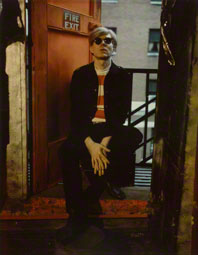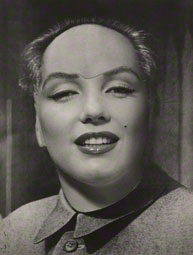 |

 |
 |
Andy Warhol, New York City, Marie Cosindas, American, 1966. © Marie Cosindas
|
 |
Photography's remarkable ability to shape identities has made it the leading vehicle for representing the famous. Soon after photography was invented in the 1830s, it was used to capture the likenesses and accomplishments of great men and women, gradually supplanting other forms of commemoration.
In the 20th century, the proliferation of photography and the transformative power of fame helped to accelerate the desire for photographs of celebrities in magazines, newspapers, advertisements, and on the Internet. Drawn exclusively from the J. Paul Getty Museum's collection of photographs, this exhibition surveys some of the visual strategies used by photographers to picture the famous from the 1840s to the year 2000.
Andy Warhol, pictured here, is one of the best-known artists of the 20th century, and had a background in commercial illustration. He is known for an aptitude for fads and recognition of the transitory nature of celebrity in consumer culture. As he famously explained, "In the future, everyone will be famous for fifteen minutes." Warhol maintained his place in the spotlight without revealing himself, insisting that neither his hand nor his persona were evident in his artwork. In this portrait by Marie Cosindas, he wears dark sunglasses, which partially conceal his face.
|
 |
|
As French Enlightenment ideals of freedom and equality took root in the social and political upheavals of the eighteenth century, the estimation of the worth of the individual also rose, thereby changing people's view of fame. The heroes of the American and French Revolutions, who cast off the trappings of royal privilege, sent a clear message to the men of the nineteenth century—regardless of position—that greatness was within the reach of those with pluck, intelligence, and talent. Called "the great democratic medium" because of its instant popular appeal and relatively low cost, photography helped to spread the idea that everyone could be and should be looked at.
This image pays tribute to Louis-Jacques-Mandé Daguerre, whose invention of one of the first photographic processes fueled a fresh appetite for portraits by offering a quick way to create and share realistic images. Though he seldom posed for portraits, here he rests one arm on a brocade tablecloth, and holds a book in what was a conventional composition that suggested refinement and learning.
|
 |
|
Gaspard Nadar created this photgraph of his friend and colleague, the French illustrator Gustave Doré, who began his career as a caricaturist, just as Nadar had before finding fame as a photographer. They became friends when both were employed by Le Journal pour rire. Nadar photographed Doré in his studio many times over the years. By the time of this portrait, Doré had received high praise for his illustrations. His loosely draped scarf, casual pose, and styled coif suggest that the young illustrator had already achieved some level of success and comfort.
|
 |
|
During the 20th century, the development of a global news media helped to make the famous an integral part of everyday life. This incessant barrage of sight, sound, and print seems to underscore the insignificance of the individual, while at the same time it makes evident the increasingly numerous ways of achieving celebrity status.
In the 1920s, American dancer and chorus girl Baker moved to Paris, where she became an international sensation. She dazzled audiences at the Folies Bergère with her scanty costumes and her salacious Banana Dance, a performance named for the skirt of bananas Baker wore on stage. De Meyer's portrait of a jovial Baker showcases her comedic charm, a trait that proved central to her popularity as a performer.
|
 |
 |

 |
 |
Portrait of Marilyn Monroe as Chairman Mao, Philippe Halsman and Salvador Dali, American and Spanish, 1952. © Halsman Archive and © Salvador Dali, Gala-Salvador Dali Foundation/Artists Rights Society (ARS), New York
|
 |
 |
|
The 20th century brought seemingly endless changes to the photographic medium, many of which had dramatic effects on the technical and stylistic results. Here two artists collaborate to create a cross between Chairman Mao Zedong (1893–1976), the leader of Communist China and symbol of revolution, with Marilyn Monroe (1926–1962), the American movie star and sex symbol. The idea for such a portrait was hatched by the Surrealist painter Salvador Dali and adroitly executed by Halsman. The clash of Eastern and Western cultural icons is both humorous and unsettling. Dali used Halsman's image when he was invited to create cover art for Vogue magazine in 1971.
|
 |
|
One of the most dramatic photographic inventions was the medium of Polaroid for color photography. In this instant color print, Caroline's aloof, imperious profile heightened by the deep shadow of Warhol's lighting shows her heritage as the daughter of American film actress Grace Kelly and Prince Rainier III of Monaco. Captured here around the time of her second marriage, Princess Caroline was no stranger to being photographed. Her young life was a swirl of yachts, designer clothes, and society parties. By twenty-six she was well aware of her responsibilities as Monaco's first lady and a favorite of the celebrity press.
|
 |





